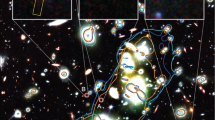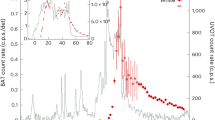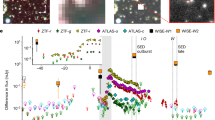Abstract
DETAILED understanding of the evolution of main-sequence stars into white dwarfs depends on knowledge of the chemical composition of white-dwarf atmospheres, but the hottest white dwarfs emit much of their radiation in the extreme ultraviolet (EUV), a part of the spectrum that has been generally inaccessible to astronomers. We report here the discovery of a new white dwarf as a bright EUV source found during the first observations using the Wide Field Camera1 on the Rosat satellite. Within the 1-arcmin error box of the EUV source is an unusually blue star, which we show to be a binary system consisting of a DA white dwarf and a cool companion in the classification range dM2–dM5. There are some similarities between this new object and the binary system Feige 24 (ref. 2), but spectral differences in the EUV emission can be attributed to significantly different atmospheric compositions for the two white dwarfs.
This is a preview of subscription content, access via your institution
Access options
Subscribe to this journal
Receive 51 print issues and online access
$199.00 per year
only $3.90 per issue
Buy this article
- Purchase on Springer Link
- Instant access to full article PDF
Prices may be subject to local taxes which are calculated during checkout
Similar content being viewed by others
References
Wells, A. et al. Proc. SPIE 1344, 230 (1990).
Thorstensen, J. R., Charles, P. A., Margon, B. & Bowyer, S. Astrophys. J. 233, 260–265 (1978).
Trümper, J. Phys. Scripta T7, 209 (1984).
Margon, B. et al. Astrophys J. 209, 525–535 (1976).
Liebert, J. & Margon, B. Astrophys. J. 216, 18–22 (1977).
Margon, B. et al. Astrophys. J. 210, L79–82 (1976).
Jacoby, G. K., Hunter, D. A. & Christian, C. A. Astrophys. J. Suppl. 56, 257–281 (1984).
Straizys, V. & Kuriliene, G. Astrophys. Space Sci. 80, 353–368 (1981).
Plummer, D., Schachter, J., Garcia, M. & Elvis, M. The EINSTEIN Observatory IPC Slew Survey. FITS A3D/CD-R0M Version (Smithsonian Astrophysical Observatory, 1991).
Barstow, M. A. Mon. Not. R. astr. Soc. 243, 182–191 (1990).
Paerels, F. B. S. & Heise, J. Astrophys. J. 339, 1000–1012 (1989).
Paerels, F. B. S., Bleeker, J. A. M. & Heise, J. Astrophys. J. 309, L33–37 (1986).
Vennes, S., Chayer, P., Fontaine, G. & Wesemael, F. Astrophys. J. 336, L25–28 (1989).
Bunclark, P. S. & Irwin, M. J. Proc. Int. Colloq. on Statistical Methods in Astronomy, ESA Spec. Publ. no. 201 (ed. Rolfe, E.) (European Space Agency, 1984).
Author information
Authors and Affiliations
Rights and permissions
About this article
Cite this article
Cooke, B., Barstow, M., Breeveld, E. et al. Detection of a new white-dwarf binary system in the extreme ultraviolet using the Rosat Wide Field Camera. Nature 355, 61–63 (1992). https://doi.org/10.1038/355061a0
Received:
Accepted:
Issue Date:
DOI: https://doi.org/10.1038/355061a0
Comments
By submitting a comment you agree to abide by our Terms and Community Guidelines. If you find something abusive or that does not comply with our terms or guidelines please flag it as inappropriate.



